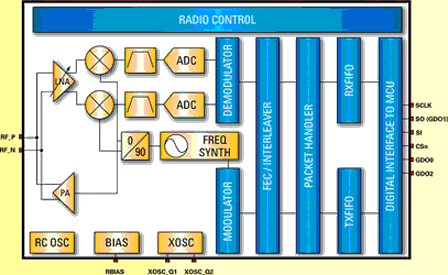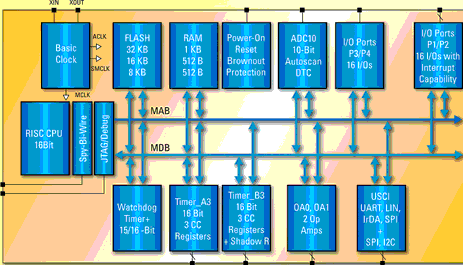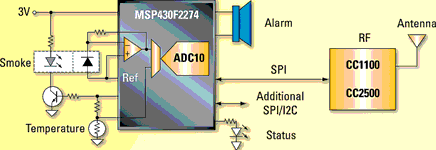
In today’s life we get more and more used to wireless links when it comes to communication, eg, wireless/cellular phones or computer networks. Despite this trend there are still many applications, which are either standalone or connected by wires.
This is especially the case for sensing or security applications. Well-known communication standards are Bluetooth and IEEE802.11 WLAN, which provide medium to high data rates, but these do not focus on ultra-low power applications.
ZigBee is a protocol based on the IEEE 802.15.4 RF standard and focuses especially on home automation applications, which are often battery-driven.
The most popular network topology for ZigBee systems are mesh networks, which can cover a wide range in homes since data can be routed dynamically across the network. No direct link is necessary between sender and receiver; a message can pass along multiple routers. The beauty of this technology is that the network can redefine itself in case new nodes or routers join the network. This enables self-healing if nodes are removed or stop operation. Compared to small proprietary stacks, which do not support multihop, the stack size is naturally larger.
In some end applications it may be very important to use a standard. However, this does not apply to all end equipment. Proprietary solutions are a good choice in security applications. This article does focus mainly on proprietary, non-multihop systems or standards like Konnex-RF, which have simpler functionality and hence smaller stack sizes.
Frequencies
Once a decision is taken to go ahead with a certain protocol, one needs to define a frequency range. This very much depends on the legislation given by the target markets. The 2,4 GHz frequency band can be used world-wide (Figure 1), but not all insurance companies permit this band to be used for security applications.

Signal propagation at 433 MHz (eg as used in Europe, South Africa, Australia) and in the 868 MHz/915 MHz range (eg Europe, US) can be better than at 2,4 GHz. This article focuses primarily on this sub-1 GHz frequency range, but most of the content applies to the 2,4 GHz products range of Texas Instruments as well.
Regardless which frequency is used, local regulations have to be taken into account. In the US, FCC rules apply, in Europe all regulations are given through ETSI, which we will be referring to. Figure 2 shows the regulations as they were. There are restrictions regarding the duty cycle and the max. output power (ERP). At the same time, the choice of an appropriate transceiver is defined by the channel spacing. While the Texas Instruments CC1100 chip is ideal for multichannel operation (50 kHz-500 kHz), the CC1020 is optimised for narrowband operation.

Newer ETSI regulations are more relaxed in terms of the ERP, but require listen before talk (LBT) techniques, ie the transmitter needs to check if the channel is idle in order to prevent interference. The new regulatory for 868 MHz is shown in Figure 3.

Transmitters are required to have a minimum TX off time of more than 100 ms and a minimum listening time tL = tF + tPS, where tF = 5 ms is a constant and tPS a random period of 0 ms ≤ tPS ≤ 5 ms. It is not required to listen before sending an acknowledgement. The maximum TX on time is 1 s, while a transmission dialogue needs to be <4 s.
Even if only one way communication is considered, LBT requires certainly a transceiver. The CC1100 provides important features, which enable not just simple development, but also cost-effective solutions. Powerful digital features allow the use of smallest microcontrollers. Low power consumption of 28,8 mA during transmission at +10 dBm output power, 15,6 mA in receive mode and only 400 nA in power-down mode make the CC1100 ideal for battery-powered applications. In addition to this, burst mode transmission with high over-the-air data rate reduces the overall power consumption. Automatic RX polling using wake-on radio requires only 1,8 μA. The sensitivity at 1,2 Kbps is -110 dBm, while the data rates are programmable in the range of 1,2 Kbps-500 Kbps.
Figure 4 shows that the CC1100 includes a packet handler that automatically generates a preamble, inserts/detects the synchronisation word, checks the address and automatically performs a cyclic redundancy check. The packet length can be defined by the user (see packet format in Figure 5).


The CC1100 is pin and register compatible with its 2,4 GHz counterpart, CC2500. This helps a lot in cases where there are spins of the same product - one that operates below 1 GHz as well as one that operates at 2,4 GHz.
In the recent past, many sensing or security products were based on pure analog circuits. Today, more and more products tend to use microcontrollers. The main advantage is flexibility, which fixed function circuits cannot provide.
The Texas Instruments MSP430 ultra-low power microcontroller family is an excellent choice for smart sensing and security applications, due to their wide variety of analog peripherals on the one hand, and their ultra-low power consumption on the other. The flexible clocking system allows changing the clock speed (max. 16 MHz) in software and offers various low power modes from which the CPU wakes up in less than 1 μs (MSP430F2xx, other derivative <6 μs). They are also a perfect fit for TI's low power wireless Chipcon product range, because these parts support the exact same supply voltage range and have very low power consumption, too.
Examples
A PIR-based motion detector for instance, is very simple to realise by choosing an MSP430 with built-in 16-bit SD ADC due to its programmable gain amplifier. Therefore, no external amplification is necessary. Hence even a wireless motion detector contains only two pieces of silicon surrounded by a minimum number of external components. Another benefit is the extremely low power consumption of less than 10 μA over time in this application. The Chipcon RF transceivers are controlled by a simple SPI link, which can be implemented easily on all MSP430 derivatives.
Another example would be an advanced, wireless smoke detector. Most smoke alarms are based on an optical chamber. When smoke enters the chamber, the light of an LED is scattered and reaches a photo diode, translating into a current. Typically this current is then converted into a voltage using a transimpedance amplifier, which consists of one or two operational amplifiers. So, even MCU-based detectors consist of quite a number of components.
To achieve more cost-effective solutions, which only use a minimum number of external components, the MSP430F22x4 microcontroller was recently introduced (Figure 6), which incorporates two internal op-amps. By software configuring, the op-amps can be either linked internally to the ADC (general purpose, inverting, non-inverting, comparator, unity gain buffer or differential mode) or connected to the external pins for use of the op-amps as external components.

Figure 7 shows an advanced wireless smoke detector design based on the MSP430F22x4. A crystal is not even necessary if the MSP430 uses its low power modes. Besides the digitally-controlled main oscillator (DCO), which provides up to 16 MHz, a new very low power oscillator (VLO) was implemented. This oscillator can be used to wake up the MSP430 periodically from standby mode. Besides lower cost and improved reliability, the power consumption is less than 0,7 μA in standby mode (LPM3). In the event that data is received while the MSP430 is in standby or even power down mode, no bits are lost because of its extremely fast wake-up time of less than 1 μs.

Development practicalities
To start the hardware development of the RF part, engineers should copy the CC1100EM reference design. A two layer reference is available for free download on the TI web page.
The schematics and layout of the EM design should be copied exactly to ensure excellent RF performance. Especially the components and PCB traces between the RF chip and the antenna are of vital importance. Both PCB traces and component values have been carefully selected and simulated to ensure good impedance matching of the antenna ('the match') and to correctly convert the differential output of the RF chip to a single-ended antenna ('the balun'). Decoupling capacitors should be kept close to the RF chip. Several design notes are available in the low power wireless section at the TI website.
The software development should be started by building the SPI link between the MSP430 and the Chipcon transceiver. Developers can benefit of the hardware abstraction layer (HAL) library, which is available from the TI website. This package supports low level hardware interface functions (ADC/Timer/SPI) to send and receive packets. It can be used with all existing MSP430 derivatives independent of the type of communication interface. It supports register read/write functions (MSP430 with CC1100 or CC2500) and includes a demo application project.
Once the hardware is developed and the MCU communicates with the transceiver, the right register settings need to be determined in order to set up the radio. TI offers a free software kit for this purpose which is called SmartRF Studio. It generates all necessary configuration data for all Chipcon's RF-ICs. Even values for the external passive components are calculated. There is an automatic code generation option in SmartRF Studio that lets the developer export code directly into his C code project.
If the SmartRF Studio is used together with the SmartRF 04EB + CC1100EM hardware, users can control the evaluation modules (EM, eg CC1100EM) though their PC to do simple performance testing.
Engineers often refer to RF as magic, especially when they have a microcontroller background. Texas Instruments offers highly integrated products like its Chipcon product range and the MSP430 microcontrollers. A large number of application notes, reference designs, software tools and libraries, are available for download free of charge. This ensures simple and efficient design of smart applications with RF links.
© Technews Publishing (Pty) Ltd | All Rights Reserved